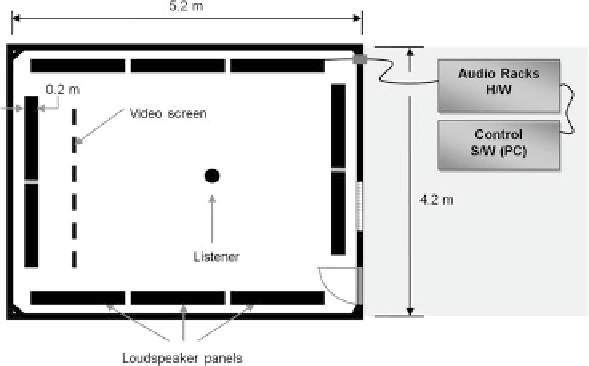Image Processing Reference
In-Depth Information
Fig. 11.5 Arrangement of loudspeaker panels for WFS in a studio
is designed with an enclosure. The optimised centre to centre distance between
two neighbouring control sources is about 18-25 cm in many practical WFS
applications. In addition, sub-woofers can also be used for low frequency
compensation.
A possible plan view of the WFS system in a studio is illustrated in Fig.
11.5
.
The reverberation effects in the WFS algorithm can be not so much significant and
rather acceptable for the system as the interior walls of the studio are covered by
absorptive acoustic panels having an absorption coefficient
varies
with the frequency of sound. The original approaches to WFS require anechoic
environment to implement an ideal global sound field reconstruction [
9
]. The
loudspeaker panels stand close to each side wall of the studio inside. The total
number of loudspeakers used as secondary sources is generally proportional to the
size of a listening room.
All the loudspeaker panels are controlled by the PC and hardware control
modules situated outside the studio to avoid any unnecessary acoustic obstacle as
shown in Fig.
11.5
. The system requires number of audio channels to control all the
loudspeakers individually. The control PC is equipped with MADI interface cards.
An up-to-date MADI interface card, e.g. RME HDSP MADI, is capable of output-
ting 64 channels of audio in MADI format [
17
]. The MADI signals are then fed via
coax into AD/DA converters which convert the signals into multi-channel audio
outputs. The control software includes a series of multi-channel audio APIs as
libraries that can be accessed easily from programming languages, such as C++,
making it easy to implement highly complicated audio DSP techniques and WFS
algorithms.
ʱ¼
0.3-0.4.
ʱ

